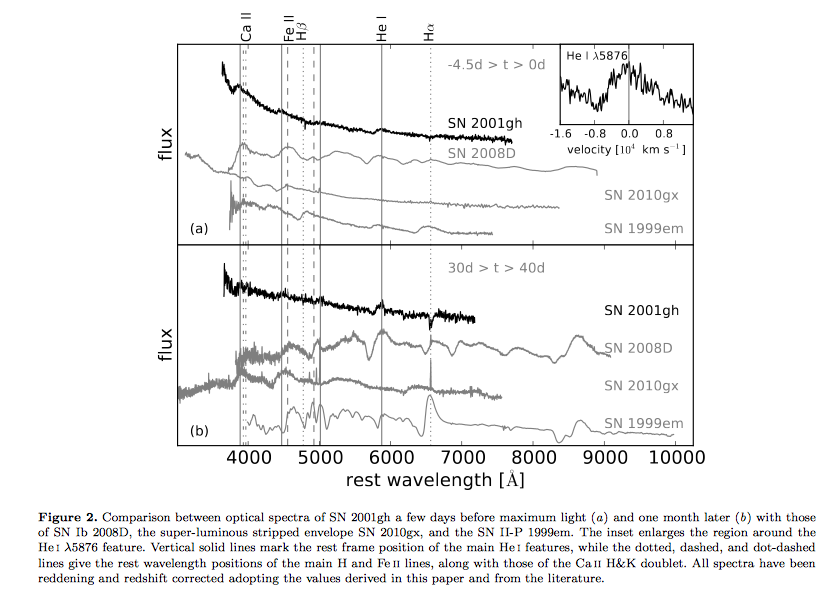Padova-Asiago Supernova Group
Highlights
Explosion of a massive, He-rich star at z=0.16
Elias-Rosa, N. et al. 2015, MNRAS 436, 109 (link to pdf)
We present spectroscopic and photometric data of the peculiar SN 2001gh, discovered by the 'Southern inTermediate Redshift ESO Supernova Search' (STRESS) at a redshift z=0.16. SN 2001gh has relatively high luminosity at maximum (M_B = -18.55 mag), while the light curve shows a broad peak. An early-time spectrum shows an almost featureless, blue continuum with a few weak and shallow P-Cygni lines that we attribute to HeI. HeI lines remain the only spectral features visible in a subsequent spectrum, obtained one month later. A remarkable property of SN 2001gh is the lack of significant spectral evolution over the temporal window of nearly one month separating the two spectra. In order to explain the properties of SN 2001gh, three powering mechanism are explored, including radioactive decays of a moderately large amount of 56^Ni, magnetar spin-down, and interaction of SN ejecta with circumstellar medium. We favour the latter scenario, with a SN Ib wrapped in a dense, circumstellar shell. The fact that no models provide an excellent fit with observations, confirms the troublesome interpretation of the nature of SN 2001gh. A rate estimate for SN 2001gh-like event is also provided, confirming the intrinsic rarity of these objects. 53
Elias-Rosa, N. et al. 2015, MNRAS 436, 109 (link to pdf)
We present spectroscopic and photometric data of the peculiar SN 2001gh, discovered by the 'Southern inTermediate Redshift ESO Supernova Search' (STRESS) at a redshift z=0.16. SN 2001gh has relatively high luminosity at maximum (M_B = -18.55 mag), while the light curve shows a broad peak. An early-time spectrum shows an almost featureless, blue continuum with a few weak and shallow P-Cygni lines that we attribute to HeI. HeI lines remain the only spectral features visible in a subsequent spectrum, obtained one month later. A remarkable property of SN 2001gh is the lack of significant spectral evolution over the temporal window of nearly one month separating the two spectra. In order to explain the properties of SN 2001gh, three powering mechanism are explored, including radioactive decays of a moderately large amount of 56^Ni, magnetar spin-down, and interaction of SN ejecta with circumstellar medium. We favour the latter scenario, with a SN Ib wrapped in a dense, circumstellar shell. The fact that no models provide an excellent fit with observations, confirms the troublesome interpretation of the nature of SN 2001gh. A rate estimate for SN 2001gh-like event is also provided, confirming the intrinsic rarity of these objects. 53
